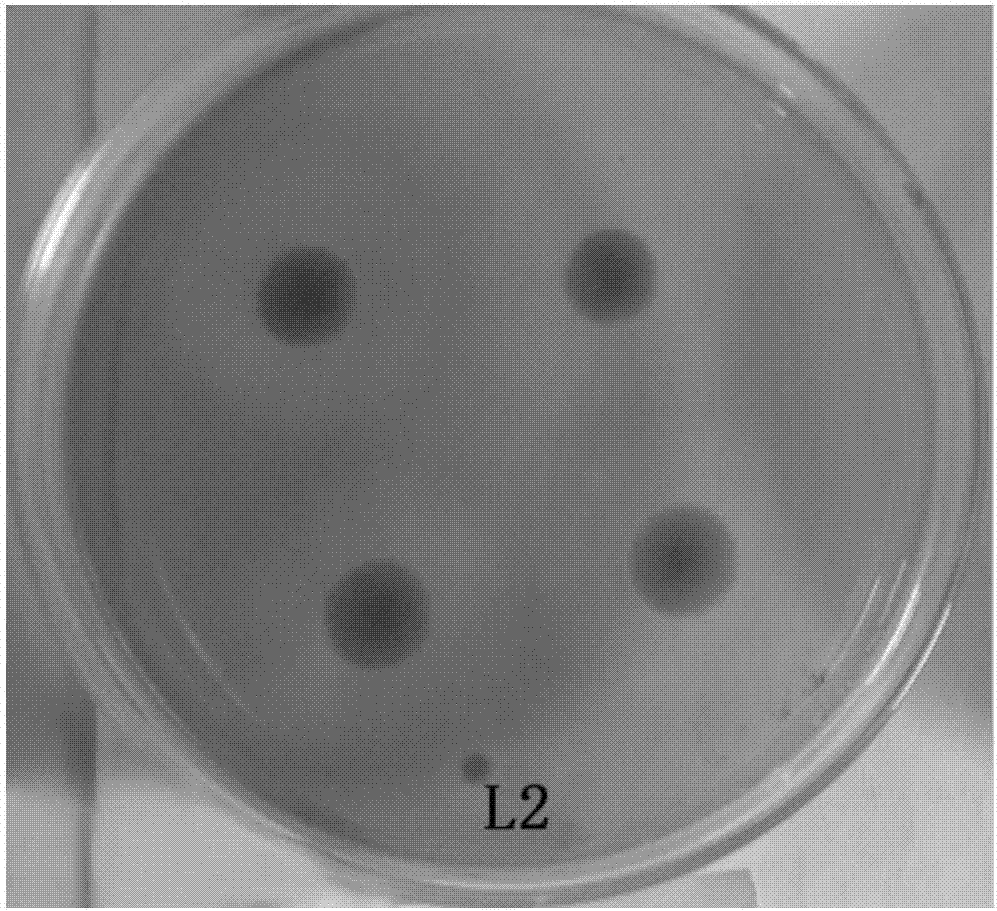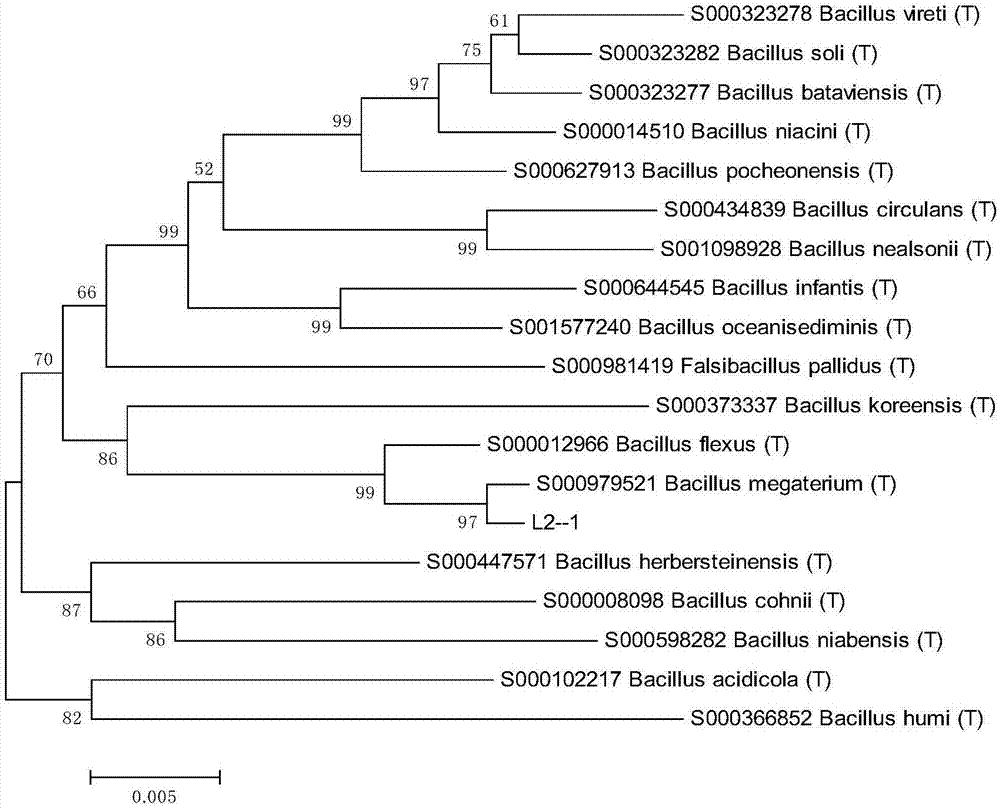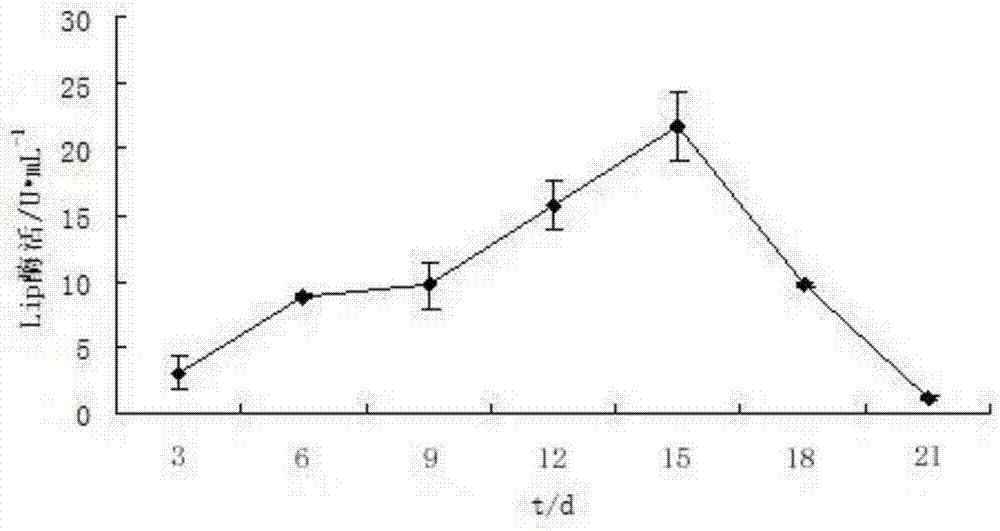Pear branch degradation bacteria L2 and inoculant thereof
A technology for bacterial inoculum and pear tree is applied in the field of agricultural waste pear tree pruning branches degrading bacteria L2 and its inoculum, which can solve the problems of air pollution, inability to return to the field, diseases and insect pests, etc., achieve broad application prospects, and promote agricultural The effect of sustainable development and environmental protection
- Summary
- Abstract
- Description
- Claims
- Application Information
AI Technical Summary
Problems solved by technology
Method used
Image
Examples
Embodiment 1
[0026] Example 1 Enrichment, isolation, screening and identification of pear branch degrading bacteria L2
[0027] 1) Enrichment of highly efficient degrading bacteria from pear tree branches: samples of degrading bacteria were collected from rotten pear tree branches piled up all year round in Lanzhou, and passed through a 20-mesh sieve to make samples. Take 0.2 g of branch samples and mix them in 20 g of solid-state enrichment medium with pear branches as the only carbon source for solid-state enrichment for 30 days, pick 0.2 g of medium with black degradation spots on the surface debris of branches, mix and inoculate into new Continue to enrich for 30d in the solid-state enrichment medium. Continue to pick 1g of the medium with black degradation spots on the surface of the branches and inoculate it into 100mL liquid enrichment medium, culture on a shaker at 160rpm, and add sterile water regularly; after 30 days, inoculate 1mL into the new liquid enrichment medium , continu...
Embodiment 2
[0032] Example 2 Degradation Enzyme Activity Determination
[0033] Inoculate the strain suspension of bacteria L2 by 1% inoculum amount (10 7 / mL) into a Erlenmeyer flask (250 mL) filled with 100 mL of liquid enzyme-producing medium, and placed at 28° C. for 21 d with shaking at 160 r / min. Samples were taken every 2 days, and the fermentation broth was centrifuged to remove bacteria and impurities to obtain a crude enzyme solution, in which the activities of lignin peroxidase (Lip) and manganese peroxidase (MnP) were determined. The result is as image 3 with Figure 4 As shown, the strain L2 can produce lignin-degrading enzymes with strong ability, fast enzyme production, and long-term enzyme production. at 10U·mL -1 The above is more than 3D, which has a good effect of producing Lip. The highest activity of lignin peroxidase is 21.76U·mL -1 , the highest activity of manganese peroxidase was 106.36U·mL -1 .
[0034] The enzyme activity of Lip is defined as the oxidat...
Embodiment 3
[0039] Example 3 Determination of Solid State Degradability
[0040] Prepare the L2 bacteria agent, the method is as follows: (1), inoculate the bacteria L2 in the LB liquid medium, shake at 30°C for 36h, so that the bacteria content reaches 10 9 / mL, the spore formation rate reaches more than 90%; (2), the bacterial suspension 6000rpm that step (1) has cultivated is centrifuged 10min, resuspended with a small amount of LB liquid culture medium, makes bacterial L2 reach 10 10 / mL, stored at 4°C for later use.
[0041] Add 5g of dried pear branch powder (40-60 mesh) and 10mL solid-state culture nutrient solution (solid-state culture nutrient solution: NH 4 Cl 2.0g, MgSO 4 ·7H 2 O 0.5g, KH 2 PO 4 1.0g, Na 2 HPO 4 0.2g, MnSO 4 0.035g, CuSO 4 ·5H 2 O 0.007g, FeSO 4 ·7H 2 (0.007g, water 1L), until the solid and liquid are mixed evenly and flat, sterilized at 121°C for 20min, inoculated with L2 bacterial agent (10 10 / mL), placed in a 30°C incubator for 30 days. Dur...
PUM
| Property | Measurement | Unit |
|---|---|---|
| Diameter | aaaaa | aaaaa |
| Diameter | aaaaa | aaaaa |
Abstract
Description
Claims
Application Information
 Login to View More
Login to View More - R&D
- Intellectual Property
- Life Sciences
- Materials
- Tech Scout
- Unparalleled Data Quality
- Higher Quality Content
- 60% Fewer Hallucinations
Browse by: Latest US Patents, China's latest patents, Technical Efficacy Thesaurus, Application Domain, Technology Topic, Popular Technical Reports.
© 2025 PatSnap. All rights reserved.Legal|Privacy policy|Modern Slavery Act Transparency Statement|Sitemap|About US| Contact US: help@patsnap.com



